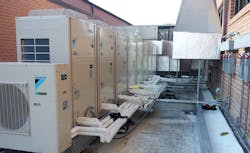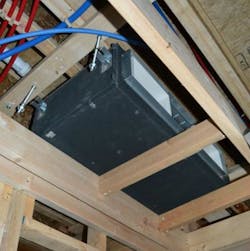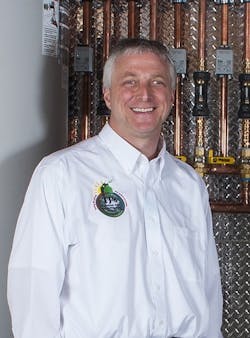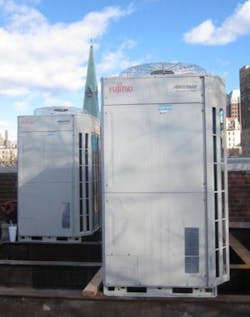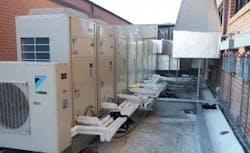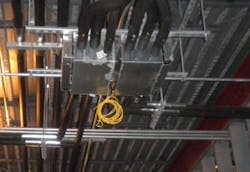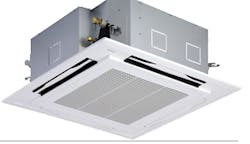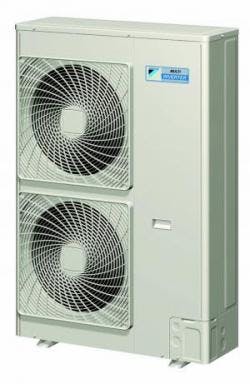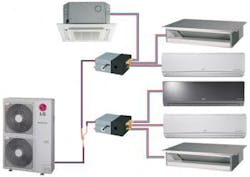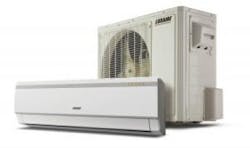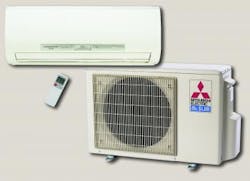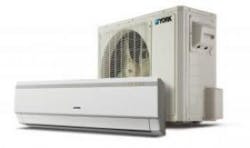VRF: Proven Technology Provides Specialized Solutions
VRF (variable refrigerant flow) or VRV (variable refrigerant volume) comfort systems consist of multiple evaporators with variable capacity, connected to one central variable-capacity inverter-driven heat pump. These systems feature a heat-recovery mode that allows the transfer of energy from zone to zone with minimal compressor use. Each zone has its own indoor air unit that precisely controls the temperature while operating at peak efficiency levels, providing an unprecedented level of flexibility for those who work together in a building.
For this article, I spoke with contractors who have successfully added VRF/VRV systems to their product lines.
He’s only been in the HVAC industry for five years, however, Lance Beaton, founder and president of VIS VIVA Energy & Services, Atlanta, GA, has been learning all he can about improving indoor comfort. He started in home performance side of the industry, and soon expanded into HVAC installation. As a former project manager for Siemens Energy & Automation, software developer, and MBA graduate, Beaton is putting his knowledge and experience to use as a business owner and provider of innovative comfort systems.
VIS VIVA — the name means “living force” — services include energy retrofits, mechanical systems, water heater change-outs, spray foam insulation, rating upgrades, and anything related to the home building performance, comfort, health, and indoor air quality niche markets. He’s certified by LEED, HERS, EnergyStar, and BPI.
Over the next 12 months, Beaton estimates his company will complete installations in 200 to 300 homes for leading Atlanta builders, using a variety of comfort technologies. In the VRF/VRV realm, he’s been trained and certified by some of the leading system providers, including Daikin, Mitsubishi, LG, and soon, Fujitsu.
Beaton installed his first VRF system in 2011. The project involved a 20-story high-rise building in downtown Atlanta, which had a very outdated and neglected boiler/chiller system. Mold issues and floor damage from a leaking system were amplified by a system that would fail every few months. The owner understandably wanted a change.
Beaton became certified in the Mitsubishi City Multi system and offered it to the homeowners’ association. “We got into a lot of very detailed conversations and presentations and managed to have a concept approved.”
Beaton and the VIS VIVA team call themselves comfort innovators.
“We deal with conceptual houses that have extremely low loads, due to the tightness of the envelope, the level of R-values, quality of windows, and solar shading. The only way you can meet those partial loads is to use a VRF system,” he says. “We tend to use a lot of fairly low static pressure ducted systems rather than the wall mounts or fan coils. If you have a tight home with very low loads, and you can use a fan coil that’s 9,000 BTUs and you only have a 3,000 BTU heating and cooling load in a basement area, the only way to properly serve that is with a VRF.
“We also like the functionality of VRF, being able to divide the house into multiple loads, with separate comfort settings for each area. So, the key benefits are partial load capabilities, efficiency, and easier zoning,” he adds.
The "Proud Green" Home at Serenbe is one of VIS VIVA’s more recent adventures into high-efficiency comfort. The sustainable home is a Design/Build collaboration with LG Squared, Inc., professionals offering architecture, HVAC, and interior design solutions for single- and multi-family homes since 2006. Serenbe is a sustainable living community south of Atlanta.
The home wlll be heated and cooled by an LG VRF ducted mini-split heat pump system. Fresh air will be provided throughout the home by ERVs by Zehnder America.
The indoor fan coil is a high-static, small chassis unit concealed between joists in the ceiling. A Multi-V Mini VRF, LG's zoned single-phase system — a commercial system that can be used in residential applications — is designed to fit where three-phase electrical is not available. The Multi V Mini is designed to provide the owner the benefits of VRF — lower operational costs per year, minimal or no duct work to purchase or install, superior comfort with room zoning — while maintaining architectural integrity.
The home’s energy consumption is projected to be “net-zero,” which means it will produce as much energy as it uses, with an on-site renewable energy source, rooftop photovoltaic panels.
The VIS VIVA team handled the entire mechanical HVAC installation at Proud Green, including spray foam insulation, air sealing, and the ERV installations.
"There are some things that are fairly unique about VRF," he says. "With LG, everything is brazed together. You have to be extremely confident in your ability to braze without getting debris into line sets, because you’re oftentimes brazing in tight quarters. You have to follow an installation protocol. Any leaks in line sets will be difficult to fix later on, because most of the refrigerant will be covered.
Regarding VRF as an overall business opportunity, Beaton emphasizes the need for a contractor to follow through on any attempts to add it to a list of comfort offerings.
“You can’t go into it half-heartedly,” he says. “You have to be committed to making it part of your core offering, and spend the time and money it takes to obtain training. And you’ll be required to purchase different types of equipment. But if you want to grow into a different service, you have to invest.”
Beaton has obtained credentials for installing multiple VRF brands, because the diversification affords him more business opportunities. “The more people we’re in tune with, the more opportunities come our way. And, each brand has its own value proposition, from static pressure, to cost, warranties, technical support, SEER ratings, or multiple fan coil adaptability. It’s simple marketing,” says the savvy 37-year old.
TJ’s Plumbing & Heating, Attleboro, MA has been in the HVAC business for 25-years, serving residential and commercial customers throughout the state of Massachusetts. The five-technician firm installs mini-split systems, traditional forced air heating and cooling, geothermal, and radiant systems.
Founder/owner Tim Cutler jumped into using VRF products about three years ago. For commercial applications, he’s certified in LG’s Multi V III, which he likes for its load diversification features. “You can heat one side of a building, cool the other, and use the waste energy from the cooling for the heating side,” he says.
In residential applications, Cutler likes the serviceability of VRF systems. “It’s very contractor friendly, from easy access to easy mounting. It’s virtually silent and very effective. We’ve installed them in bedrooms; that’s how quiet they are.”
Cutler’s strategy in designing VRF for a home application begins with explaining it as an option for areas without ductwork. Aesthetics are a key point.
“It’s mostly based on learning whether the client is fine with having a mini-split cassette on the wall. A lot of clients aren’t willing to do that, and for those customers we use LG’s 12,000 BTU high static, ducted air handler system. Photo of LG PEA-A12AA4.
“VRF provides multi-zone capabilities, which allows the client much more flexibility, all from one compressor section. You might have four or five air handlers throughout a home, which allows for more zone control. It’s also a simplified set-up. You wire it up, everything communicates, and it’s easy for the end-user and easy for the contractor to install.”
A Fujitsu Airstage VRF system was recently the product of choice for a wing of the St. Charles Borromeo Church, Brooklyn, NY. A 145-year old neo-gothic brownstone, the church administrators were of no mind to do anything that might require altering the building’s classic woodwork. And, being located on a tight, tree-lined street, lifting a standard rooftop unit to the roof was out of the question. A Fujitsu VRF provided the solution.
“Since the VRF condensing units are a little bit smaller, they were brought up in an elevator. Then, we temporarily removed a section of the stairwell, and hoisted the unit to the roof,” explains Brendan Casey, commercial product manager for Fujitsu General America, Inc.
“The main advantages included being able to install it without interfering with the interior woodwork. Individual air handlers in each room made VRF the better choice for this building,” Casey says. “Each room has a ducted unit, and there are 12 air handlers in the building to heat and cool a chapel, three residences, and meeting rooms.
Brian Stack is president of Stack Heating & Cooling, Avon, OH. He hasn’t let the company’s 36-year history of providing traditional comfort systems stop him from also offering VRF systems by Mitsubishi. He says they offer advantages that can’t be denied.
“VRF units serve a great purpose,” Stack says. “I like the range of applications they offer, and Mitsubishi continues to update the products.
“We’re using VRF in some older homes that don’t have air conditioning, or for people who are putting on an addition to a family room, or a sun room,” Stack explains. “They’re cost effective, and give homeowners an alternative to putting an entire duct system in the home. Or, we might install them in a home that has steam heat, where they can be used for heating in fall and spring. Some homeowners in older homes don’t like the way they look on the wall, and would still rather go with the high velocity mini-duct system, even though they’re more expensive. A lot of it comes down to personal preference.”
Joel Hill, LEED AP, is branch manager for Direct Expansion Solutions (DXS), Houston, TX, a leading manufacturer’s representative for Daikin VRV products. He believes VRV or VRF systems have come into their own.
“When the equipment was first sold, the price point was pretty high, because the manufacturers had lower sales volumes, a higher cost of distribution, costs related to setting up shop in the U.S. Engineers weren’t as adept at specifying VRV as they are now, there were inefficient specifications and designs, and systems were expensive to install and projects went over budget.
In the last five to seven years, the distribution volumes are substantially higher than they were five years ago, so the cost point for equipment has come down a good 20% over last seven years. In addition, the contractors and reps have figured out some ‘sweet spots,’ to the point where today, the total installation cost for a VRV system will be somewhere between cost of a VAV package rooftop system and a air-cooled chiller/small chilled water system.
Hill anticipates that VRV equipment and total installation cost will trend down to where it’s fairly comparable to commercial rooftop units.
Daikin’s VRV III series is well-suited to large-sized buildings. It provides outdoor units that extend air conditioning capacity up to 54 HP. It incorporates a wide range of outdoor and indoor units, long actual and total piping length, and high external static pressure. The VRV III series provides power and versatility for flexible VRV III design and easy installation in large-sized buildings. The Heat Recovery series also enables simultaneous cooling and heating, meeting the various needs for temperature control.
“Daikin will be manufacturing in the U.S. starting next year, so we’ll have domestic manufacturing, reengineering of product that’s best suited for the U.S. market, and different controls options to allow contractors to take full advantage of VRV systems,” Hill says. “And, the cost point will be in line with other systems we’re already using. It will be comparable to the more commercial grade rooftop systems. If I had to project, I would say the determining factor will be the specifics about the building.”
FOLLOW CONTRACTINGBUSINESS.COM ON TWITTER @CONTRACTINGBIZ
New VRF Products Announced
Trane’s new Advantage VRF variable refrigerant systems for commercial applications are variable speed driven, and offer customizable solutions for improved temperature control and occupant comfort in an energy-efficient package that reduces operating expenses, sources now report.
As described by Trane sources, using refrigerant to move energy around the building is far more efficient than other conventional heating, ventilation and air conditioning systems. Variable-speed compressor technology precisely matches energy use to the demands of the building and only heats and cools the areas that require it. The units range from 3- to 36-ton outdoor units which require no equipment room to ½- to 7 ½ ton indoor units, which can be concealed above ceilings or installed in the desired space.
The systems offer simultaneous heating and cooling, transferring energy within a building to provide cooling to one area while providing heating to another area of the same building. This feature creates a solution for buildings with multiple zones that naturally heat up and cool down in varying patterns.
“Moving away from a ‘one setting fits all’ approach to heating and cooling reduces conflict among tenants over temperature control settings and reduces complaints about indoor climate for operators,” says Dave Patlovich, product manager for Trane Ductless Systems. “The new systems deliver individualized solutions to meet our customers’ unique needs.”
Carrier is expanding its Variable Refrigerant Flow (VRF) offerings to now include heat recovery models under the name Toshiba Carrier SHRM-i. This new generation of VRF units delivers innovative technology that optimizes and balances each component in the system to enhance reliability and efficiency. Toshiba Carrier SHRM-i VRF systems boast multiple inverter-driven compressors that are compatible with Puron refrigerant (R-410A). Toshiba Carrier SHRM-i three-pipe heat recovery VRF systems are ideal for applications that require simultaneous heating and cooling, maximizing efficiency by transferring energy from one indoor zone to another through refrigerant piping.
“Working with Toshiba, we are pleased to expand our VRF offering in North America to provide heat recovery options for our customers,” says Greg Alcorn, Carrier vice president, commercial sales and marketing. “The new VRF offering expands Carrier’s vast portfolio of products to meet customer’s specific needs.”
American Standard The American Standard ductless system provides a home comfort solution when retrofitting older homes, cooling or heating new rooms, spot cooling and heating and building new construction. It also provides the highest quality of comfort and reliability for homeowners who want a dependable comfort solution with enhanced flexibility. The systems are available in mini- and multi-split applications.
Coleman
Johnson Controls expands the Coleman Echelon series and LX series product lines to include ductless mini-split air conditioners and heat pumps.
Coleman mini-splits come in either single-zone units, providing individualized comfort in a single room, or multi-zone units, connecting a single outdoor unit to up to five indoor units, providing comfort in multiple areas. The mini-splits use a wireless remote controller with a built-in temperature sensor that controls and satisfies the cooling or heating set point temperature where the remote control is located.
Daikin AC
Daikin AC introduces the new 8-zone multi-split system (RMXS48LVJU) targeting light commercial and whole-house residential markets. The 4-ton 8-zone system is an energy-efficient (up to 18.8 SEER, and 11.3 HSPF) high-capacity heat pump system incorporating Daikin’s famed VRV technology, with the ability to connect from 2 to 8 indoor units with a single, compact outdoor unit. The inverter-driven compressor provides precise capacity adjustments for efficiency and accuracy in comfort control, and allows long piping lengths (up to 180-ft. to the branch provider, over 440-ft. total loop) for added installation flexibility.
LG
LG Electronics USA introduces a multi-zone duct-free split heat pump system that provides heating and cooling for up to eight separate zones, while increasing overall capacity by up to 50% compared to previous LG multi-zone models. The new LG “Multi F Max” system (LMU540HV) increases capacity to a nominal capacity of up to 54,000 btuh, from the previous multi-zoned system capacity of up to 36,000 btuh. Adding branch distribution to LG’s Mult F product family also effectively doubles the number of potential temperature control zones available, now offering up to eight individual zones for customized comfort.
Luxaire
Johnson Controls adds ductless mini-split air conditioners and heat pumps to the Luxaire Acclimate series and LX series product lines. The mini-split systems’ smaller footprint eliminates the costs and hassles of installing ducts and bulky air handlers. The mini-splits use a wireless remote controller with a built-in temperature sensor that controls and satisfies cooling or heating set point temperatures wherever the remote control is located.
Mitsubishi
Mitsubishi Electric has introduces new systems that are ENERGY STAR-rated and qualify for federal tax credits. The MSZ-GE09NA and MSZ-GE12NA systems with wall-mounted indoor units feature high SEER and HSPF ratings.
The MSZ-GE systems offer:
• dingle-zone cooling-only and heat pump models in 9,000, 12,000, 15,000, and 18,000 btuh capacities
• all heat pump indoor units are also compatible with the MXZ-B series multi-zone system
• high efficiencies of up to 20.5 SEER.
York
Johnson Controls adds ductless mini-split air conditioners and heat pumps to the York Affinity series and LX series product lines. Most models in the Affinity series are ENERGY STAR certified, with Seasonal Energy Efficiency
Ratios (SEER) ranging from 16 to 27 to ensure energy-efficient performance and comfort.
The mini-split systems’ smaller footprint eliminates the costs and hassles of installing ducts and bulky air handlers. Single-zone mini-splits provide individualized comfort in a single room, while multi-zone models connect a single outdoor unit to as many as five indoor units, providing comfort in larger areas.
VRV DESIGN BOOTCAMP
Direct Expansion Solutions, Houston, TX will conduct a VRV Design Bootcamp for engineers and Design/Build contractors engaged in design and commissioning responsibilities for Daikin VRV systems.
The bootcamp will be held Friday, June 7, from 9am until 1 pm at 3350 Yale St., Houston, TX 77018. Breakfast and lunch will be provided.
The boot camp will include:
- VRV vs. Inverter Unitary: when to use each
- Heat pump vs. heat recovery vs. heat pump with external heat.
- Ductless vs. ducted
- Piping design
- Breaking down the VRV impact on other trades
- Options for OA
- Miscellaneous drawing details
- Making VRV do what you want (controls setup and configuration; understanding the BAS interface process)
- Commissioning agent's role
- VRV IV: a sneak peak at the next generation of Daikin VRV products
- Q&A with "the VRV guy," Joel Hill.
TO REGISTER, CALL 832-328-1010
